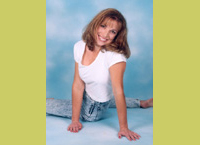

 Tissue Recipient Sponsor: AlloSource |
|
|
Karen Garber began running at age 12 and came to need and love the freedom that running gave her. To help others reach their fitness goals, she became a Personal Trainer. Her knees started to fail her and eventually deteriorated to the point that she could no longer work, run, teach, do simple chores around the house or garden, or even play a game of soccer or basketball with her children. Thanks to a donated bone allograft, Karen was able to return to her active life. “Without donors and their families,” she writes, “I know my life would never have been the same.” Karen's Story Growing up as an active kid, always fit and on the go, I never thought I would end up with an injury to my knees that would ultimately alter my adult life and possibly my career. I began running at age 12 when my two brothers ran cross country in high school. I continued to run throughout the years, and came to need and love the freedom that running gave me. Running and fitness became my passion. So that I could share that passion and help others reach their fitness goals, I began to teach aerobics, which led me to become a Personal Trainer. I ignored my sore knees, and continued to increase my teaching. However, my knees progressively became more and more painful, causing me to cease my Personal Training, and teaching. My running came to an abrupt end. I struggled both emotionally and physically. I could no longer work, run, teach, do simple chores around the house or garden, or even play a game of soccer or basketball with my children. I began to gain some weight, and my life became an emotional rollercoaster, causing my family to struggle along with me. I visited Dr. Doug Wyland at Steadman Hawkins Clinic in Denver, Colorado, in early 2004. By the end of 2004, my right knee was becoming more crippling. Anticipating the same problem as on the left, the MRI results proved to be much different and shocking to all of us. A large 18mm hole had formed in the trochlea that was caused by some type of severe trauma. I was diagnosed with a condition called OCD (osteochondral defect). While I’ve known about organ donation and all the lives that donors and their families save, I now learned about bone and tissue donation. Dr. Wyland explained that the lesion was too deep to replace by using my own bone and the only viable option was that of a fresh bone allograft through a donor. I had very serious concerns about the use of a fresh graft; everything from the possibility of contracting a disease, to rejection of the bone. After visiting AlloSource in Denver, Colorado and discussing my concerns with the AlloSource staff and Dr. Wyland, some of my anxieties were lessened and I agreed to the allograft, receiving a bone and tissue transplant in March 2005. The bone transplant has given me another chance: a chance to share with others how bone donation has enhanced my life and allowed me to return to my life again; how critically important it is to become a donor; and the huge impact it has on so many people who need donors. Without donors and their families, facilities like AlloSource, and the technology and skill of doctors as Dr. Wyland, I know my life would never have been the same. I would like to thank my donor, my donor’s family and all who give the gift of life and enhance lives like mine. |
